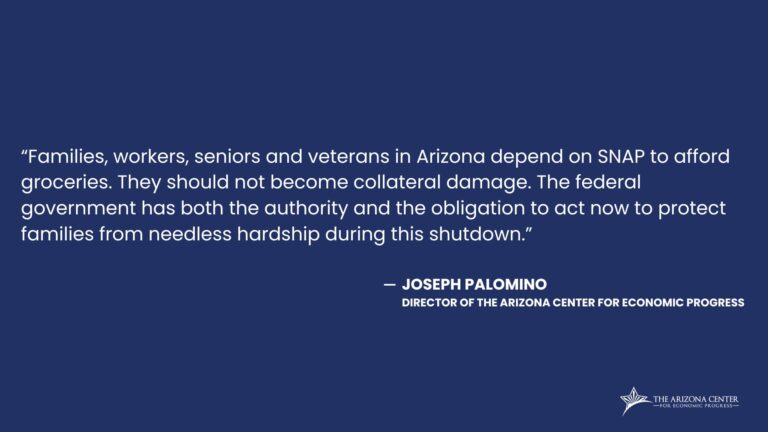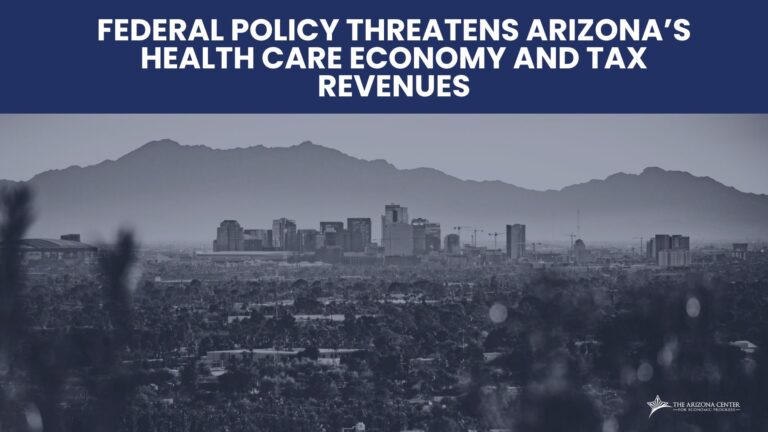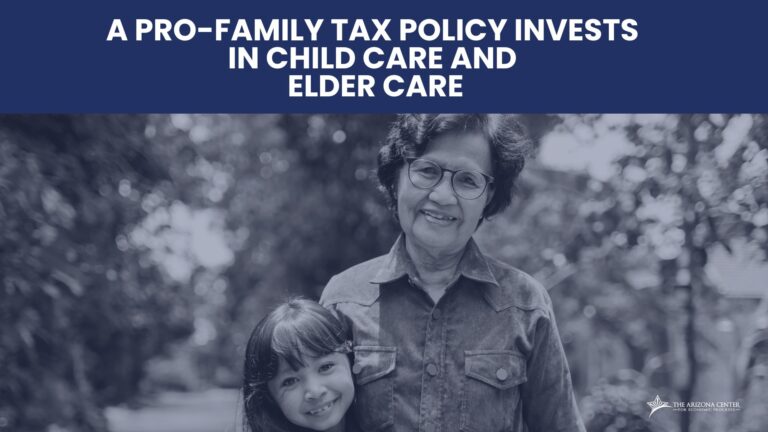
ProPublica feature strengthens case for improving cash assistance in Arizona
Recent reporting from ProPublica and the Arizona Republic has vividly depicted the consequences of the Arizona state government’s approach to the Temporary Assistance for Needy Families (TANF) program. As ProPublica documents in its Welfare States series, state government discretion over how to spend TANF funds and decisions about who qualifies for assistance have led to sometimes strange but often difficult requirements for families seeking help across the American southwest.
Arizona has become a national example for lowering benefits, erecting barriers, and limiting pathways to participating in the TANF cash assistance program, with many of these measures being adopted in the aftermath of the Great Recession. With no minimum eligibility requirements and overly broad purposes of the cash grant at the federal level, states like Arizona have put assistance out of reach for many families. Since TANF’s inception, fewer and fewer Arizona families with children in poverty have been able to access the cash assistance program. In 2019, for every 100 Arizona families with children in poverty, only 6 participated in cash assistance (this is referred to as the “TANF-to-poverty” ratio).
Arizona’s cash assistance benefit level ($278 per month for a single-parent family of three with no other income) is among the lowest in the country. This benefit is 15% of the federal poverty level, placing it 45th among the states and the District of Columbia. While every state increased benefits (at least in nominal terms) for the Aid to Families with Dependent Children program (TANF’s predecessor) between 1970 and 1996, Arizona is one of four states to cut benefits since without restoring them. Cutting benefits, like restricting eligibility, has prevented Arizona’s cash assistance program from reducing poverty in the state. As of 2019, nearly 1 in 5 children in Arizona were growing up in poverty, a statistic that has changed little in the 25 years since the enactment of TANF.
Geographic variation (as evidenced by Arizona’s restrictions) bears significant consequences for racial inequities. In the U.S., Black children are likelier and Latino children are somewhat more likely than White children to live in states with the lowest TANF-to-poverty ratios. The legacy of racism in public benefit programs continues in TANF policies today, including work requirements, time limits, and other behavioral requirements that compound the challenges faced by Black and Latino families experiencing poverty.
While these benefit cuts and strict eligibility requirements have eroded the effectiveness of Arizona’s cash assistance program, the state has used the majority of its TANF funds to prop up its Department of Child Safety (DCS), instead of funding that agency through the state’s General Fund. The federal government technically allows states to spend TANF this way; but given that most DCS cases are for neglect where a lack of economic resources is a risk factor, the use of TANF in child welfare merely addresses a symptom of poverty. In addition to cash assistance, these funds diverted to the DCS could be used for a variety of programs and services, including work supports and additional child care assistance for low-income families.
While Arizona’s misguided approach to TANF has deprived many families of crucial support, it is squarely within the Legislature and Governor’s power to make necessary improvements. In recent years, legislators have introduced bills to make marginal improvements to the program. And this year, Senate Bill 1623 (introduced by State Senator Rios) and House Bill 2797 (introduced by State Representative Powers Hannley) contains a set of policy changes that together can improve access to and adequacy of TANF cash assistance. Below is a summary of its provisions:
Restores the minimum monthly cash assistance amount and ties it to prices: Arizona provides a maximum of $278 per month in cash assistance to a single-parent family of three with no other income. Arizona cut benefits in the aftermath of the Great Recession, and has never restored them, leaving today’s participating families with 52 percent less purchasing power than participating families in 1996. This benefit is 15 percent of the federal poverty line, placing Arizona 45th among the states and the District of Columbia. SB1623 and HB2797 would raise the weekly benefit to be no less than 40 percent of the federal poverty level of the prior calendar year, which would allow the benefit to automatically adjust with prices. (The benefit for a 3-person family would increase from $278 to $768 per month).
Increases the time limit for participating in cash assistance: Arizona limits participation in cash assistance to 12 months, the shortest in the country and one-fifth of the federal time limit Studies have shown that families who reach the time limit are more likely to have significant barriers to employment (such as health issues) and fare worse in the labor market than others who leave the program. While some families can get a twelve-month extension if they comply with work and school attendance requirements, families that are most likely to need more time are excluded. SB1623 and HB2797 would move Arizona to a standard 60-month time limit.
Restores eligibility to pregnant people without other children: States can grant cash assistance eligibility to pregnant people without other children. In 2010, Arizona ended such eligibility, and remains the only state of its neighbors to retain such as restriction. Restoring eligibility for cash assistance is a means to address disparities in maternal and infant health. SB1623 and HB2797 would restore this eligibility (subject to rules adopted by the Department of Economic Security).
Repeals the ban on drug felons from receiving cash assistance: Arizona is one of seven states that still maintain a full lifetime ban on people with drug felony convictions from receiving cash assistance—a vestige of punitive, failed policies enacted as a part of the war on drugs. While the 1996 federal TANF legislation included this ban, states can partially or wholly lift it, as more than a dozen states have done since 2015. A partial restriction also exists for the Supplemental Nutrition Assistance Program (SNAP, formerly known as food stamps) in Arizona. SB1623 and HB2797 repeal this ban for SNAP and TANF in Arizona.
Repeals sanctions that affect a whole family’s cash grant: Arizona’s cash assistance program has a “full-family sanction” – a penalty applied against a whole family if they are out of compliance with TANF work requirements (cutting benefits by half for one month on the first instance, and then cutting benefits off completely after the second). This unnecessarily punishes children—who the grant is supposed to support—for behavior of adults in the household. Studies have also shown that Black, Latino, and Native American TANF participants are disproportionately penalized. SB1623 and HB2797 would limit penalties to a specified “adult” portion of the cash assistance and leave a larger “child” portion unaffected.
Repeals the family cap: Arizona is one of eleven states to retain a “family cap” for cash assistance—which denies additional assistance to households who have another child while receiving TANF. Rooted in racist, sexist narratives of “welfare queens” having children to collect more cash assistance, studies show that family caps have had little impact on birth rates among TANF recipients, all the while causing unnecessary hardship for these very families. DES indicates that 1,472 Arizona children were denied assistance in 2020 because of the family cap policy. SB1623 and HB2797 would repeal Arizona’s family cap.
Restores cash assistance for kinship caregivers: Cash assistance can be provided to TANF-eligible children being cared for by TANF-ineligible relatives or other adults—referred to as “child only” cases. But in the aftermath of the Great Recession, Arizona limited the definition of “child only case” to deny cash assistance eligibility for kinship caregivers when the child was not part of an active DCS case. This prevents many children that stay with kin or other adults from receiving cash assistance, though they face identical challenges to those who are in the foster care system. SB1623 and HB2797 would restore the definition of “child only” to include children without active DCS cases.
Making these changes to eligibility will require re-directing more TANF dollars to the cash assistance program (and in turn, greater General Fund support of DCS to replace TANF funds). Fortunately, the state’s fiscal health presents a major opportunity. Despite the lingering pandemic, Arizona’s revenues have reached historic highs, in large part due to multiple federal economic rescue pages. According to the Joint Legislative Budget Committee (JLBC), Arizona has $1 billion in ongoing and $2.1 billion in one-time revenues. More than any other time, fiscal constraints are no excuse for bolstering Arizona’s cash assistance program and reversing years of harmful benefit cuts and restrictions.
Photography by Caitlin O'Hara for ProPublica



